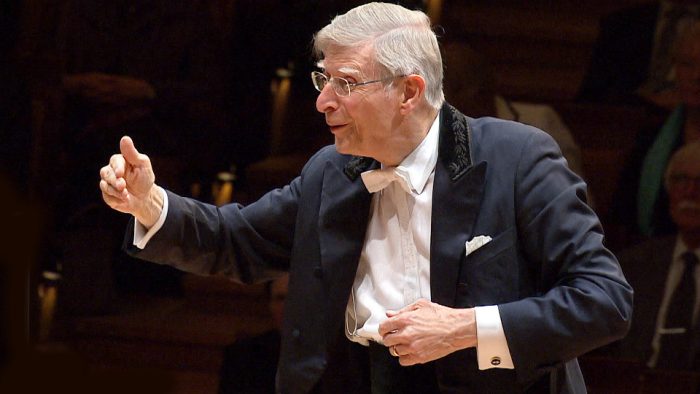
Philadelphia Orchestra performs Mozart and Brahms, February 2017.
During the 44 years when Eugene Ormandy was music director of The Philadelphia Orchestra (1936 to 1980), he led almost every concert. There was scant need for guest conductors.
Now the symphonic world is different. All prominent conductors dash from one city to another, and Yannick Nézet-Séguin needs to do this more than others because he also is music director of the Orchestre Métropolitain in Montréal, the Rotterdam Philharmonic Orchestra, and is music director designate of the Metropolitan Opera.
Therefore, we’re concerned about who is booked to conduct the Philadelphians during all the weeks when Yannick is unavailable. The return of Herbert Blomstedt in mid-February for a set of three concerts was salutary.
The Swedish-American Blomstedt is Conductor Laureate of the San Francisco Symphony Orchestra where he served as music director from 1985 to 1995. He’s an unassuming man, age 89. His career never achieved superstar magnitude but he’s beloved by musicians. Blomstedt’s extensive discography includes over 130 works with the Dresden Staatskapelle where he also was music director for many years.
Short, slender, and white-haired, Blomstedt was genial and animated as he led the Brahms Symphony No. 3 seated in a chair. He conducted with his bare hands, no baton, and often signaled the orchestra with the mere extension of his forefinger. He changed the Philadelphians’ seating to the classical arrangement of first violins to his left, second violins to his right, cellos directly in front of him and basses in the left rear of the stage. (Yannick normally seats all the violins to his left, and cellos and basses to his right.)
Maestro Blomstedt fell in San Francisco one week earlier and suffered a few bruises. There was fear that he might need to use a cane during these concerts with The Philadelphia Orchestra, but that turned out not to be necessary.
Blomstedt’s musical approach was unmannered, trusting the markings of the composer; no noticeable ritards or speed-ups, no heavy accentuations. That approach worked perfectly in this piece, the quietest and most pastoral of Brahms’s four symphonies. He achieved the ideal balance between sticking to the text while never sounding pedantic, which is a rare accomplishment. Often he swayed back and forth in his chair while encouraging the orchestra.
Brahms wrote the symphony in 1883 in a studio overlooking the Rhine valley, and its tone seems to reflect that setting. Most of it is contemplative and peaceful, with moments of joy. I’ve always felt it to be comparable to Beethoven’s Sixth (the Pastorale) — even more so than Brahms’s radiant Second Symphony. Brahms told friends that he was a “free but happy man” (he never married) and he chose the notes that corresponded to the initials of those words in German, F–A flat–F, as a motif that recurs throughout the symphony.
All of the four movements end quietly, although the last movement does have a heroic section. Blomstedt achieved a sense of proportion between colorful sonorities and classical structure. The start of the movement was, intentionally, close to inaudible, and the hushed final chord has never sounded more serene.
His Symphony No. 1 was written in a bold, Beethovenesque style, and his Symphony No. 2 was meditative, alternating between happy and brooding moods. Brahms wrote that it was “melancholy.” This Third finds the composer at his sunniest, and leaves the listener with the most contented feelings. Brahms’s Symphony No. 4, in contrast, is his most monumental work. Nézet-Séguin leads the Philadelphians in that piece during the last weekend of February.
The first half of the program displayed a similarly balanced account of Mozart’s Piano Concerto No. 25 with Garrick Ohlsson as soloist. The pianist is a large hulk of a man, towering over Blomstedt, but they matched each other evenly in a restrained, classic rendition.
Mozart composed this concerto at the age of 30, nearing the height of his career (contemporaneous with his Marriage of Figaro). It’s in a symphonic vein, with the piano an equal partner with the orchestra, rather than being a showpiece for the soloist. Ohlsson has demonstrated great power on many occasions, but here he restrained himself to an elegant partnership.
Although Blomstedt led the Brahms without a score, and obviously knows the Mozart from memory, he used a score during the concerto in order to give the soloist greater confidence.
Even though Blomstedt turns 90 this year, we hope this is the start of an enduring relationship between him and this orchestra.
This review orginally appeared in DC Metro Theater Arts.